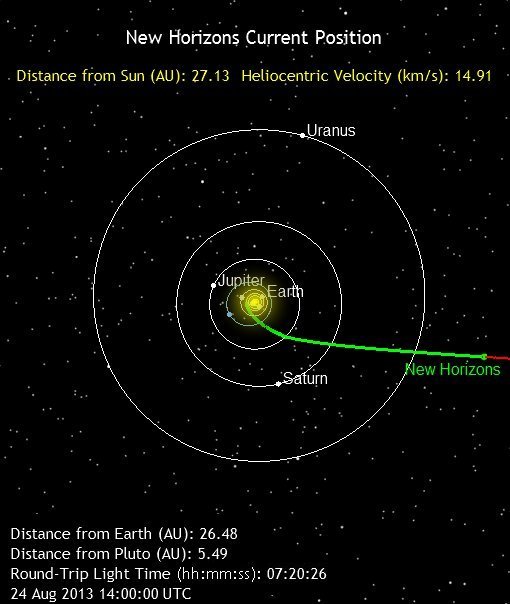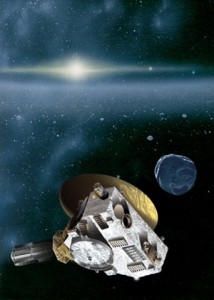August 24, 2006. On this date Pluto was demoted from full planet to dwarf planet status.
This decision by the International Astronomical Union (IAU) remains controversial among some scientists and many laypeople. And even as Pluto continues to stir controversy on Earth, a spacecraft is winging its way toward the outer solar system – and an encounter with Pluto in 2015. The New Horizons spacecraft will be the first spacecraft ever to sweep closely past Pluto. Mission principal investigator Alan Stern of the Southwest Research Institute spoke with EarthSky about the IAU’s decision in May of 2011. The following is a re-print of that interview.
EarthSky: Why are we going to Pluto?
Alan Stern: We’re going on New Horizons not to rewrite the textbooks but to write the textbooks for the first time about how dwarf planets work, how they operate, how their geology behaves, how they evolved through time, what their moons are like. It’s really going to be revolutionary.

EarthSky: When New Horizons launched in 2006, Pluto was still classified as a planet. Just a few months later, the International Astronomical Union voted to demote Pluto to dwarf planet status. How do you feel about the IAU’s decision?
Alan Stern: I think it’s really obvious to many if not most planetary scientists that objects of this scale, thousands of kilometers across, are planets. They have all the attributes of planets. They have crusts and cores; they have atmospheres and moons; they have seasons. And we can go on down the list.
To every recognizable attribute that we associate with planethood, Pluto is a planet. And many planetary scientists and, of course, many people in the public just discount the IAU’s wrongheaded vote and still consider it a planet, as I do, because we know that if you were to show up in a spacecraft at Pluto and take a look, you certainly wouldn’t classify it as a rock or anything else. It’s obviously a planet by every comparison.
I like to make the analogy that a chihuahua is still a dog.
EarthSky: Tell us more about the New Horizons mission.
Alan Stern: We launched the mission in January of 2006 on a nearly 10-year voyage all the way across the depths of space to the farthest planet ever explored. Even though we’re the fastest mission ever launched, it takes nine and a half years to get there. Today … the spacecraft is speeding on towards its arrival at the Pluto system in July of 2015.
The spacecraft is in great health. The instruments are working perfectly. We have lots of fuel on board, not just to explore Pluto and its moons, but to go on deeper into the Kuiper Belt, and I just couldn’t be happier. We have a great team of people taking care of the spacecraft, planning the encounter. And we can’t wait for 2015.


EarthSky: What’s going on with New Horizons now?
Alan Stern: One of the secrets of New Horizons, the way that we keep the costs down, is that we’re a very small team. And the same people who plan our operations every year have to also plan the Pluto encounter.
And so we put the spacecraft to sleep, turn off many of the unnecessary systems a lot like you might put your house to sleep if you went on vacation. Not everything is turned off. You leave a few lights on. The phone still rings. You might turn the air conditioner on to a different temperature to save energy.
We do something very similar with New Horizons about nine months out of the year. And we have to wake it up a couple of times during the year, the main event of which is every summer, we wake up for about 10 weeks to test all the onboard systems, to test and recalibrate our instruments, sometimes to improve the onboard software, those kinds of things.

EarthSky: We’ve heard you speak of what you called the “Star Trek test” for what qualifies as a planet. Tell us about that.
Alan Stern: It’s not really based on Star Trek, but I use Star Trek as an illustration. All of us have watched Star Trek. And whenever a starship shows up in a new place, and they turn on the viewfinder on the bridge, the audience knows within a moment, as does the crew on the bridge, whether they’re orbiting a star or spacecraft, or a planet, or a little asteroid or what-have-you.
They don’t need to survey the whole solar system. They don’t need to integrate orbits. It’s pretty easy to tell a planet when you see one, just by its attributes.
EarthSky: You said a few years ago you believe that when New Horizons passes Pluto and the pictures are sent back, everyone who looks at those pictures will agree that Pluto should have retained full planet status. Do you still feel that way?
Alan Stern: I think they’ll think, wow, what was all the controversy about? That’s obviously a planet.
Bottom line: On August 24, 2006, Pluto was demoted from full planet status to dwarf planet status. A spacecraft is now en route to Pluto. Alan Stern, lead scientist of the New Horizons mission to Pluto, talked to EarthSky in 2011 about the mission and about the IAU’s decision to demote Pluto. This post contains a re-print of that 2011 interview.











